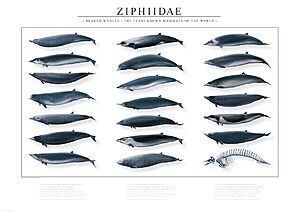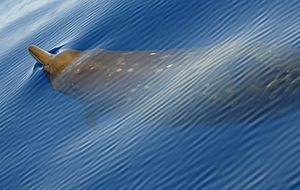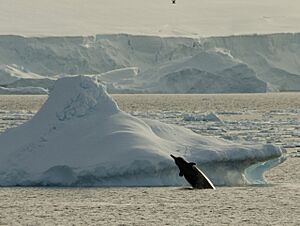Beaked whale facts for kids
Quick facts for kids Beaked whale |
|
|---|---|
 |
|
| Baird's beaked whale (Berardius bairdii) | |
| Scientific classification |
|
| Kingdom: | Animalia |
| Phylum: | Chordata |
| Class: | Mammalia |
| Order: | Artiodactyla |
| Infraorder: | Cetacea |
| Parvorder: | Odontoceti |
| (unranked): | Physeterida |
| Superfamily: | Ziphioidea |
| Family: | Ziphiidae Gray, 1850 |
| Type genus | |
| Ziphius Cuvier, 1823
|
|
| Genera | |
|
See text |
|
| Synonyms | |
|
|
Beaked whales are a special group of cetaceans, which are ocean mammals like dolphins and porpoises. They are known as one of the least-known mammal groups. This is because they live in the deep sea and are very shy. There are about 24 types of beaked whales, but only a few are well-known. Some, like Baird's beaked whale and Cuvier's beaked whale, were hunted in Japan. The northern bottlenose whale was also hunted a lot in the North Atlantic Ocean long ago.
In 2020, people thought they found a new type of beaked whale off the coast of Mexico. Scientists are still studying it to be sure.
Contents
What Do Beaked Whales Look Like?
Beaked whales are medium-sized, from about 4 to 13 meters (13 to 43 feet) long. They can weigh from 1 to 15 tons. Their most special feature is their 'beak', which looks a bit like a dolphin's nose. They also have two grooves under their throat that come together. Unlike some other whales, their tail fluke (tail fin) does not have a notch.
Most beaked whales have only one or two pairs of teeth. These teeth usually only show in males. Females' teeth stay hidden in their gums, except for Berardius whales. Male and female beaked whales can look different in size. Males often have a big, bulging forehead. But besides teeth and size, males and females look very similar.
It's hard to tell different beaked whale types apart in the ocean. You have to look closely at small differences. These include their size, color, forehead shape, and how long their beak is.
Their Unique Teeth
Beaked whales are special among toothed whales because most have only one pair of teeth. These teeth look like tusks. They are usually only seen in male whales. Males likely use these tusks when they compete for females. Female whales' teeth do not grow out and stay hidden.
In 2008, scientists studied the DNA of many Mesoplodon beaked whales. They found that the males' teeth are like antlers on male deer. They are a way for males to show off. Each type of whale has teeth with a unique shape. For some, like the strap-toothed whale, their teeth curve over their upper jaw. This makes it hard for them to open their mouth wide! Females might choose mates based on the shape of their teeth. This is because the different types of whales look very much alike.
We don't know much about how beaked whales live together. But sometimes, one male is seen with many females. This suggests that one male might mate with several females.
Beaked Whale Species
There are at least 22 types of beaked whales. Several new types have been found in the last 20 years. Scientists have put them into six main groups, called genera.
Beaked whales are the second-largest family of cetaceans, after dolphins. They are a very old group of whales. The oldest beaked whale fossils are about 15 million years old.
Here are some of the main groups and types of beaked whales:
- Order Cetacea (all whales, dolphins, and porpoises)
- Suborder Odontoceti (toothed whales)
- Family Ziphiidae (Beaked whales)
- Genus Berardius
- B. arnuxii, Arnoux's beaked whale
- B. bairdii, Baird's beaked whale
- Berardius minimus, Sato's beaked whale
- Genus Hyperoodon, bottlenose whales
- H. ampullatus, northern bottlenose whale
- H. planifrons, southern bottlenose whale
- Genus Indopacetus
- I. pacificus, tropical bottlenose whale
- Genus Mesoplodon, mesoplodont whales
- M. bidens, Sowerby's beaked whale
- M. bowdoini, Andrews' beaked whale
- M. carlhubbsi, Hubbs' beaked whale
- M. densirostris, Blainville's beaked whale
- M. eueu, Ramari's beaked whale
- M. europaeus, Gervais's beaked whale
- M. ginkgodens, ginkgo-toothed beaked whale
- M. grayi, Gray's beaked whale
- M. hectori, Hector's beaked whale
- M. layardii, strap-toothed whale
- M. mirus, True's beaked whale
- M. peruvianus, pygmy beaked whale
- M. perrini, Perrin's beaked whale
- M. stejnegeri, Stejneger's beaked whale
- M. traversii, spade-toothed whale
- M. hotaula, Deraniyagala's beaked whale
- Genus Tasmacetus
- T. shepherdi, Shepherd's beaked whale
- Genus Ziphius
- Z. cavirostris, Cuvier's beaked whale
- Genus Berardius
- Family Ziphiidae (Beaked whales)
How Beaked Whales Live
Amazing Deep Dives
Beaked whales are known for diving incredibly deep. They often dive deeper than 500 meters (1,640 feet) to find food. They use echolocation (like sonar) to find prey in the dark depths. After a very deep dive, they often do several shallower dives. Sometimes, they spend over an hour near the surface to breathe.
In 2014, scientists found that Cuvier's beaked whales can dive at least 2,992 meters (9,816 feet) deep! This is a record for any mammal. Another study in 2020 reported a Cuvier's beaked whale that stayed underwater for 222 minutes. This is also a record for a mammal.
Diving so deep and holding their breath for so long is hard. Whales have special bodies to help them. They have large spleens and livers, which help filter their blood. They can also hold their flippers tightly against their bodies. This makes them more streamlined for swimming fast underwater. When they dive, their heart rate slows down. Blood flow changes to make sure important body parts get enough oxygen. Their lungs also collapse, which helps them avoid problems from pressure.
What Do They Eat?
All beaked whales have special grooves on their throats. These help them with their unique way of eating: suction feeding. Instead of catching prey with their teeth, they suck it into their mouths. The throat grooves stretch to make room for the food. Their tongues can move very freely. By quickly pulling their tongue back, they create a strong suction that pulls prey and water into their mouth.
Scientists have learned about their diet by looking at the stomachs of whales that washed ashore. Beaked whales mostly eat deep-water squid. They also eat fish and some small crustaceans that live near the sea floor. Some marks found on the sea floor might even be from beaked whales feeding!
To learn more about their hunting, scientists put recording devices on Cuvier's and Blainville's beaked whales. These whales hunt using echolocation in deep water. This is where most of their food is found, between 200 and 1,885 meters (656 to 6,184 feet) deep. They usually catch about 30 prey items per dive. Cuvier's beaked whales often hunt at 1,070 meters (3,510 feet) for about 58 minutes. Blainville's beaked whales typically hunt at 835 meters (2,740 feet) deep for about 47 minutes.
Where Do They Live?
Beaked whales live in many different parts of the world's oceans. You can find them from the cold ice edges near the North and South Poles to the warm waters near the equator. Each type of beaked whale has its own specific home range. But generally, they live in offshore waters that are at least 300 meters (984 feet) deep.
They like to gather in deep waters near the edges of continental shelves. They also like areas with underwater mountains (seamounts), canyons, and oceanic islands. Places like the Azores, the Canary Islands, and Hawaii are known spots for them.
Life Cycle and Social Groups
We don't know much about the life of beaked whales. The oldest Baird's beaked whale found was 84 years old. A female was 54. For other types, the oldest recorded age is between 27 and 39 years. They become adults and can have babies when they are between seven and 15 years old. Pregnancy lasts about 17 months for Baird's beaked whales and 12 months for northern bottlenose whales. We don't have much information on how often they have babies.
It's hard to count how many beaked whales are in a group. This is because they are very quiet when they come to the surface. Groups can range from one to 100 whales. But for some types, like northern and southern bottlenose whales, groups are usually small. They average 2.5 to 3.5 whales, with a maximum of 20. Berardius whales and tropical bottlenose whales can be found in much larger groups, up to 100 whales.
We also don't know much about how beaked whale groups are made up. Scientists have studied northern bottlenose whales, Blainville's beaked whales, and Baird's beaked whales the most. Female northern bottlenose whales seem to have loose friendships. But some male northern bottlenose whales stay together for years. Blainville's beaked whale groups often have several females, their babies, and young whales. It's thought that one male might live with several females and their young. Baird's beaked whales can be found in groups with many males, or large groups with both male and female adults. Arnoux's beaked whales have also been seen in large groups of up to 47 whales near Antarctica.
Protecting Beaked Whales
For a long time, beaked whales were safe from human activities because they lived in remote, deep-sea areas. But now, there are several concerns:
- Pollution: Studies of beaked whales that wash ashore show increasing levels of toxic chemicals in their blubber.
- Plastic: Like other top predators, beaked whales can be harmed by pollution. They can eat plastic, which can be very dangerous for them.
- Fishing Nets: More beaked whales are getting caught in deep-sea fishing nets.
- Decompression Sickness: They can suffer from a problem similar to "the bends" in human divers.
A big worry for beaked whales is modern sonar. Sonar uses sound waves to detect things underwater. When naval ships use mid-frequency active sonar (MFAS), it seems to scare beaked whales. This makes their hearts beat faster. They might try to swim to the surface too quickly to get air. This fast swim can cause them to get decompression sickness.
When whales that washed ashore after naval exercises were examined, scientists found bleeding near their ears or gas bubbles in their bodies. These problems are similar to decompression sickness in humans. Gas bubbles can harm their nervous system, heart, and breathing. In their inner ear, it can cause bleeding, making them confused or dizzy.
Whales that hold their breath for a long time, like beaked whales, can get decompression problems. This is a possible reason for why so many beaked whales wash ashore when sonar is used nearby. If a whale is deep underwater and hears loud sonar, it might have little oxygen left. It needs to get to the surface to breathe. Avoiding the sonar would mean changing its swimming pattern. So, sonar close to beaked whales can cause them harm, leading them to wash ashore.
Research shows that Cuvier's and Blainville's beaked whales are most affected by sonar. These whales have washed ashore after military exercises in places like Greece, the Bahamas, and the Canary Islands. Their livers often showed the most damage.
In 2019, a report looked at all the evidence about beaked whale strandings linked to sonar. It said that sonar affects Cuvier's beaked whales the most. But the effect can be different for each whale or group. It might depend on if they have heard sonar before. The report concluded that the most likely reason for the decompression sickness found in stranded whales is their reaction to sonar. It also noted that no more mass strandings happened in the Canary Islands after sonar use was banned there. The report suggested banning sonar in other areas where strandings still happen.
Four types of beaked whales are listed as "lower risk, conservation dependent" by the IUCN. These are Arnoux's and Baird's beaked whales, and the northern and southern bottlenose whales. We don't know enough about the other types to classify them.
Beaked Whales in Captivity
Beaked whales do not live long in captivity. Most only survive a few days outside the ocean. This is very different from other whales like common bottlenose dolphins. The longest a beaked whale has lived in captivity was 25 days. In 1989, two male beaked whales, named Alexander and Nicholas, washed ashore in California. Their exact type was not known. They were taken to Marine World California. Both whales sadly died of pneumonia. Nicholas died on September 8th, and Alexander died 10 days later.
A few other beaked whales have been kept briefly. In 1956, a young female Cuvier's beaked whale was found near Santa Catalina Island. She was taken to Marineland of the Pacific and named Martha Washington. In 1969, a Cuvier's beaked whale washed ashore in St. Augustine. This whale was taken to Marineland of Florida. We don't know what happened to this whale, but it was alive on June 18, 1969.




